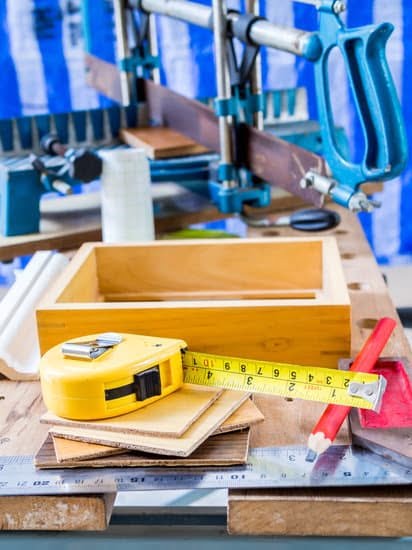Woodworking is a craft that requires not only skill and craftsmanship but also a deep understanding of its unique terminology. From dovetails to mortise-and-tenon joints, learning these terms is essential for any woodworker striving to excel in their craft.
One such term that may pique your interest is “rebate,” which has a significant role in woodworking projects. In this article, we will delve into what exactly the term “rebate” means in woodworking and explore its various applications and benefits.
When it comes to woodworking, understanding the terminology is crucial as it lays the foundation for effective communication within the woodworking community. Just like any trade, woodworking has its own set of technical terms that define specific operations or features. Whether you are a novice woodworker or an experienced carpenter, having a solid grasp of these terms will not only help you comprehend project instructions but also enable you to express yourself clearly when discussing your ideas with others.
Now, let’s turn our attention specifically to “rebate” in woodworking. This term refers to a technique where a portion of the wood material is precisely removed from an edge or face of a workpiece to create a recess or groove.
Rebates serve multiple purposes ranging from enhancing joint strength and stability to providing an aesthetically pleasing detail on furniture pieces. In this article, we will dissect the concept of rebates in greater detail, exploring their historical context, practical applications, variations, creation techniques, common mistakes to avoid, and advanced tips for achieving excellent results.
By expanding your knowledge and understanding of rebates in woodworking, you open up new possibilities for creating stunning projects with enhanced functionality and visual appeal. So let’s dive into this fascinating topic and unlock the potential that rebates hold for your woodworking ventures.
Defining “Rebate” in Woodworking
In the world of woodworking, there are countless terms and techniques that may seem unfamiliar to beginners. One such term is “rebate.” Understanding what this term means and how it is used in woodworking is essential to becoming a skilled craftsman or craftswoman. In this section, we will provide a clear definition of the term “rebate” in woodworking, highlight its significance in carpentry and furniture making, and explore its historical context.
What is a Rebate?
A rebate in woodworking refers to a specific type of joint commonly used when constructing furniture or other wooden structures. Also known as a rabbet or a dado, a rebate is created by cutting out a groove or channel along the edge or face of a piece of timber. This groove allows another piece of wood to fit into it, creating a secure and seamless connection between the two pieces.
The Significance of Rebates
The use of rebates in woodworking serves several purposes, both functional and aesthetic. Functionally, rebates provide structural strength by increasing the surface area for glue or other adhesives to bond two pieces together. Moreover, they allow for hidden joinery where nails or screws would be unsightly or impractical. Aesthetically, rebates can hide joints from view, enhancing the overall appearance of an object and giving it a more polished look.
Origin and Historical Context
The history of using rebates in woodworking reaches back centuries. This technique can be traced to ancient civilizations like Egypt and China where skilled craftsmen employed it to construct various wooden artifacts such as doors, cabinets, and trunks. In traditional European furniture making during the Middle Ages and Renaissance periods, rebates were widely utilized for their strength and versatility.
Today, the concept of creating rebates remains fundamentally unchanged, although advancements in tools and techniques have made the process more precise and efficient. Woodworkers continue to incorporate this age-old technique into their projects, showcasing the enduring legacy of rebates in woodworking.
The Purpose and Benefits of Creating Rebates in Woodworking Projects
Creating rebates in woodworking projects serves multiple purposes and offers a range of benefits to woodworkers. One of the main reasons why woodworkers use rebates is to join two pieces of wood together securely. By incorporating rebates, woodworkers can create strong joints that withstand the test of time.
In addition to providing structural integrity, rebates also offer aesthetic advantages. When properly executed, rebates can add visual interest and sophistication to woodworking projects. They can serve as decorative stops or edges, enhancing the overall design and giving a polished look to furniture or carpentry pieces.
Furthermore, utilizing rebates allows for efficient use of materials. By removing excess material from one piece of wood and creating a groove or notch, woodworkers can save on cost and waste. Rebates provide a means of making precise adjustments in dimensions while ensuring a solid fit between components.
Real-life examples abound where rebates play a crucial role in woodworking. For instance, when constructing cabinetry, rebates are often used for frame-and-panel construction. In this method, rebated edges are created on the frame pieces to receive the panels securely within them. This not only strengthens the cabinet structure but also provides a clean and seamless appearance.
Another example comes from making doors or windows. Rebates enable precise fitting of glass panes into frames by creating recesses that hold the glass securely in place without obstructing its visibility from either side.
Overall, incorporating rebates in woodworking projects offers both functional and aesthetic benefits. Whether it’s creating strong joints, enhancing design elements, or maximizing material efficiency, understanding and utilizing rebates add value to every woodworker’s skillset.
Different Types of Rebates
An Overview of Different Types of Rebates
In woodworking, there are various types of rebates that craftsmen utilize to achieve specific outcomes in their projects. Each type of rebate serves a unique purpose and has its own set of applications. By understanding the different variations of rebates, woodworkers can incorporate them effectively into their designs and enhance the functionality and aesthetics of their creations.
Standard Rebate
The standard rebate, also known as a rabbet, is one of the most common types used in woodworking. It involves removing material from the edge or surface of a piece of wood to create a groove or recess. This type of rebate is often used for joined construction or to accommodate other pieces during assembly. For example, in cabinet making, a standard rebate may be created on the back edges of cabinets to provide space for the cabinet back panels.
Sash Rebate
A sash rebate is commonly employed in window making or any project that involves glass fitting. It is usually created on the inner edges of frames to hold glass panes securely in place. The sash rebate provides a neat and precise recess that ensures proper positioning and prevents the glass from shifting or rattling within the frame.
Dado Rebate
The dado rebate involves removing material across the grain to create a rectangular slot or groove in woodworking projects. This type of rebate is often used to accept shelves, dividers, or panels within furniture pieces such as bookcases or cabinets. By incorporating dado rebates, woodworkers can achieve strong and sturdy joints while maintaining an organized and aesthetically pleasing appearance.
Stop Rebate
A stop rebate is designed to serve as a stopping point for another piece within an assembly. It typically has shoulders on one or both sides to provide a precise location for the stop. The stop rebate is commonly used in door frames or casework to create clean and defined boundaries for various components.
Lipped Rebate
A lipped rebate, also known as an inset rebate, involves adding a lip or ledge to the edge of a piece of wood. This type of rebate is often used in cabinetmaking to allow doors or drawers to sit flush with the front face of the cabinet. The lip provides stability and allows for smooth opening and closing while maintaining a seamless appearance.
By familiarizing themselves with these different types of rebates, woodworkers can gain a deeper understanding of their applications and effectively incorporate them into their woodworking projects. Whether it’s joining pieces together, accommodating glass panels, creating slots for shelves, establishing stopping points or achieving flush surfaces, choosing the appropriate type of rebate can greatly enhance both the structural integrity and overall aesthetic appeal of woodworking creations.
Tools and Techniques for Creating Rebates
Creating rebates in woodworking requires specific tools and techniques to ensure precision and clean results. To successfully undertake this process, woodworkers should have the following essential tools in their arsenal: a marking gauge, chisel set, router plane or shoulder plane, and a mallet or hammer.
The first step in creating a rebate is measuring and marking the desired depth and width of the rebate on the wood surface using a marking gauge. This tool helps ensure accuracy by allowing woodworkers to control the depth of the rebate easily.
Next, use a chisel set to define the edges of the rebate by removing excess material along the marked lines. It is crucial to gradually remove material with each pass of the chisel to avoid any unnecessary damage.
For those who prefer power tools, a router plane or shoulder plane can be used to create rebates efficiently. These tools allow for precise and uniform removal of material and are particularly useful when working on larger woodworking-headphones/” target=”_blank” rel=”follow noopener”>woodworking projects. After removing most of the waste material with these planes, finish shaping the rebate with a chisel to achieve clean and crisp edges.
Throughout this process, it is important to test-fit any components that will be inserted into the rebate after each step. This ensures that the dimensions of the rebate are accurate and allows for any necessary adjustments before proceeding further. Once satisfied with the fit, secure all components together using appropriate fasteners such as screws or glue.
To achieve even greater precision and efficiency in creating rebates, some woodworkers may employ specialized techniques such as using a router table or employing jigs for consistent results. These techniques can help streamline production processes when working on multiple identical rebates.
By mastering these tools and techniques for creating rebates in woodworking projects, woodworkers can achieve professional-grade results while enhancing both functionality and aesthetics. Practice is key when learning how to create rebates effectively, so don’t hesitate to experiment with different approaches until finding what works best for your specific projects.
Common Mistakes to Avoid When Creating Rebates in Woodworking
Creating rebates in woodworking projects requires precision and attention to detail. While this technique offers numerous benefits, it is important to be aware of common mistakes that can occur during the process. By understanding these pitfalls and knowing how to avoid them, woodworkers can achieve the desired results and maximize the potential of their projects.
One common mistake when creating rebates is not accurately measuring or marking the depth and width of the rebate. This can result in a poor fit or misalignment with other components of the project. To prevent this, it is crucial to carefully measure and mark the dimensions of the rebate before making any cuts. Using a marking gauge or a combination square can help ensure accurate measurements.
Another mistake to avoid is rushing through the cutting process without proper support or clamping. Without support, the timber may splinter or tear out, compromising the quality of the rebate. To prevent this, woodworkers should use appropriate clamps or supports to securely hold down their workpiece, especially when using power tools such as routers or table saws.
Additionally, insufficient tool maintenance can also lead to mistakes when creating rebates. Dull blades or bits can cause rough cuts, tear-outs, and overall poor quality results. It is essential to regularly sharpen tools such as chisels, planes, and router bits to maintain optimal performance. Proper tool maintenance includes honing edges and cleaning out any residue that may affect cutting efficiency.
By being mindful of these common mistakes and taking preventative measures while creating rebates in woodworking projects, enthusiasts can greatly improve their craftsmanship and achieve professional-looking results.
- Accurately measure and mark dimensions before making any cuts
- Use appropriate clamps or supports
- Maintain sharp blades and bits through regular tool maintenance
Advanced Tips and Tricks
Woodworking is a craft that requires skill and precision, especially when it comes to creating rebates. In this section, we will explore some advanced tips and tricks that can help enhance your rebate-making skills and take your woodworking projects to the next level.
One important tip is to invest in high-quality tools specifically designed for creating rebates. Having the right tools can make a significant difference in the quality of your work. Some essential tools for making rebates include a rebate plane, a shoulder plane, and a chisel set. These tools will allow you to achieve clean and accurate results.
Another tip is to pay attention to the grain direction when making rebates. The grain direction can affect the ease of cutting and the overall strength of the rebate joint. It is generally recommended to orient the cut with the grain for better results. Additionally, using sharp blades or chisels will also help ensure clean cuts and prevent tear-out.
In terms of techniques, one useful trick is to make multiple passes when cutting deep rebates. This helps prevent tear-out and allows you to control the depth more precisely. You can start by making shallow cuts and gradually deepen them until you reach the desired depth. This technique is particularly useful when working with hardwoods or delicate materials.
By implementing these advanced tips and tricks, you can enhance your rebate-making skills and achieve professional-looking results in your woodworking projects. Remember to practice patience and precision, as mastering this technique will take time and experience.
| Tool | Purpose |
|---|---|
| Rebate plane | Used for cutting precise rebates |
| Shoulder plane | Ideal for trimming shoulders after cutting a rebate |
| Chisel set | Enables precise and clean corner cuts for rebates |
Real-life Examples
Woodworking is a craft that combines skill and creativity to create beautiful and functional pieces of furniture. One important technique in woodworking is the use of rebates. In this section, we will explore some real-life examples of stunning woodworking projects that incorporate rebates, highlighting the role they play in enhancing both the design and functionality of these pieces.
One example of a woodworking project that showcases rebates is a wooden bookshelf. This particular bookshelf features several shelves with rebates along the edges.
These rebates serve two purposes: they create a smooth and seamless transition between the shelves, giving the bookshelf a clean and polished appearance, and they also provide support for the books, preventing them from slipping off the edges. The rebates in this project not only contribute to its aesthetic appeal but also improve its functionality as a book storage solution.
Another example where rebates are prominently used is in constructing cabinets. Cabinets often have doors with inset panels that fit into rebates on the interior frame to create a flush surface.
This not only enhances the visual appeal of the cabinet by creating clean lines but also ensures that the doors fit securely and close properly without any gaps or misalignment. The use of rebates in cabinet making allows for precise fitting and contributes to the overall durability and longevity of the piece.
One more example of stunning woodworking projects incorporating rebates is in picture frames. Picture frames with intricate designs often require rebate cuts to perfectly hold the glass, artwork, or photograph in place. Whether it’s an ornate frame with decorative beading or a simple minimalist design, incorporating rebates ensures that everything fits snugly together while maintaining a seamless look.
By examining these real-life examples, we can see how woodworkers leverage rebate techniques to achieve both aesthetic and functional goals in their projects. Rebates offer versatility in woodworking by allowing for precise fitting, maximizing strength, and enhancing visual appeal. These examples showcase the incredible potential of rebates in woodworking projects and inspire woodworkers to explore this technique in their own creations.
Conclusion
In conclusion, understanding and utilizing the concept of rebates in woodworking can greatly enhance both the functionality and aesthetics of your projects. By creating a recessed groove or step on the edge of a piece of wood, you open up a world of possibilities for joinery, alignment, and design.
Throughout this article, we have explored the definition and historical context of rebates, discussed their purpose and benefits in woodworking, delved into various types of rebates and their applications, provided a step-by-step guide for creating them, and highlighted common mistakes to avoid.
By incorporating rebates into your woodworking projects, you can achieve stronger joints that withstand the test of time. Rebates not only maximize contact surface area between wood pieces but also provide added support and stability. Whether you are building furniture, cabinetry, or decorative items, adding rebates can ensure precise alignment while improving overall structural integrity.
Moreover, rebates offer endless opportunities for enhancing the visual appeal of your woodworking creations. From neatly concealing hardware to creating striking designs with contrasting wood species or inlays, rebates allow for creative customization that adds unique character to each project. By carefully selecting variations such as stopped or through rebates and exploring advanced techniques like double-rebating or dovetailing rebates, you can elevate your woodworking skills to new heights.
Frequently Asked Questions
Why is it called a rabbet in woodworking?
The term “rabbet” in woodworking refers to a groove or recess that is cut into the edge of a piece of wood. It is believed that the word originated from the Old French word “rabattre,” which means to beat back or reduce.
This association may have emerged because when a rabbet is created, it involves removing part of the wood to create a step or ledge, essentially reducing the overall thickness or size of the material. Over time, this technique became known as a “rabbet” in woodworking terminology.
How do you put a rebate on wood?
To put a rebate on wood, also known as creating a rabbet, several steps need to be followed. First, determine the desired dimensions and depth of the rebate. Then, using appropriate measuring tools such as a marking gauge or ruler, mark these measurements onto the edge of the wood.
Next, use a marking knife or chisel to carefully score along these markings, defining the edges of the rebate clearly. Once prepared, you can use various hand tools like chisels or planes specifically designed for rabbeting to gradually remove material until you achieve the desired depth and width of the rebate.
What is the difference between a planer and a rebate planer?
While both planer and rebate planer are woodworking tools used for shaping and smoothing surfaces, there are important distinctions between them. A planer is primarily used to level and flatten larger wooden surfaces by consistently shaving off thin layers until achieving an even finish throughout the entire piece.
On the other hand, a rebate planer specializes in creating rebates or rabbets along either an edge or face of wood by cutting away specific areas rather than rendering an even surface across an entire board’s length.

Hi everyone! I’m a woodworker and blogger, and this is my woodworking blog. In my blog, I share tips and tricks for woodworkers of all skill levels, as well as project ideas that you can try yourself.




